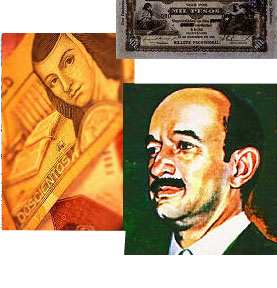REQUIRED
-
Andres Oppenheimer, Bordering on Chaos: Guerrillas,
Stockbrokers, Politicians, and Mexico's Road to Prosperity (Boston:
Little, Brown, and Co., 1996), p. 3-15, 215-34.
-
Manuel Pastor and Carol Wise, "State Policy, Distribution,
and Neoliberal Economic Reform in Mexico," Journal of Latin American
Studies, May 1997 (29):419-56.
-
Peter Smith, "Political Dimensions of the Peso
Crisis," in Sebastian Edwards and Moises Naim, eds., Mexico 1994:
Anatomy of an Emerging-Market Crash (Washington, DC: Carnegie
Endowment for International Peace, 1997), p. 31-54.
-
Denise Dresser, "Falling from the Tightrope: The
Political Economy of the Mexican Crisis," in Sebastian Edwards and
Moises Naim, eds., Mexico 1994: Anatomy of an Emerging-Market
Crash (Washington, DC: Carnegie Endowment for International
Peace, 1997), p. 55-80.
-
Rogelio Ramirez de la O, "The Mexican Peso Crisis
and Recession of 1994-95: Preventable Then, Avoidable in the Future,"
in Riordan Roett, ed., The Mexican Peso Crisis: International
Perspectives (Boulder, CO: Lynne Rienner, 1996), p. 11-33.
- Sebastian Edwards, "The Mexican Peso Crisis: How
Much Did We Know? When Did We Know It?" The World Economy,
January 1998, 21 (1):1-26.
RECOMMENDED
-
Moises Naim, "Mexico's Larger Story," Foreign
Policy, Summer 1995 (99): 112-30.
-
John Williamson, "Mexican Policy toward Foreign
Borrowing" and "Comment" by Enrique G. Mendoza in Barry P. Bosworth,
Susan M. Collins, and Nora Claudia Lustig, eds., Coming Together:
U.S.-Mexican Relations (Washington, D.C.: Brookings, 1997).
-
Jeffrey Frieden, "The Politics of Exchange Rates,"
in Sebastian Edwards and Moises Naim, eds., Mexico 1994: Anatomy
of an Emerging-Market Crash (Washington, DC: Carnegie Endowment
for International Peace, 1997), p. 81-94.
-
Luis A. Riveros, "Chile's Structural Adjustment:
Relevant Policy Lessons for Latin America," in Albert Berry, ed.,
Poverty, economic reform & income distribution in Latin America
(Boulder, CO: Lynne Rienner, 1998), p. 111-36.
-
Ernest Bartell, "Perceptions by Business Leaders
and the Transition to Democracy in Chile," in E. Bartell and Leigh
A. Payne, eds., Business and Democracy in Latin America (Pittsburg:
University of Pittsburg Press, 1995), p. 49-79.
-
Denise Dresser, "Neopopulist Solutions to Neoliberal
Problems" (La Jolla: Center for U.S.-Mexican Studies, 1993).
-
Nora Lustig, Mexico: The Remaking of an Economy
(Washington, DC: Brookings, 1998), p. 143-200.
-
Sebastian Edwards and Moises Naim, eds., Mexico
1994: Anatomy of an Emerging-Market Crash (Washington, DC: Carnegie
Endowment for International Peace, 1997), p. 95-245.
-
Javier Santiso, "Wall Street and the Mexican Crisis:
A Temporal Analysis of Emerging Markets," International Political
Science Review, January 1999, 20 (1):49-71.
-
Thomas Kessler, "Political Capital: Mexican Financial
Policy under Salinas," World Politics, 1998, 51 (1):36-66.
-
Albert Fishlow, "A Tale of Two Presidents: The
Political Economy of Crisis Management," in Alfred Stepan, ed.,
Democratizing Brazil: Problems of Transition and Consolidation
(Oxford: Oxford University Press, 1989).
- John Williamson, ed., Latin American Adjustment:
How Much Has Happened (Washington, DC: Institute for International
Economics, 1990), p. 54-84, 95-8 (remarks by Patricio Meller and comments
by Vittorio Corbo).
LITERARY OVERLAY
- Andres Oppenheimer, Bordering on Chaos: Guerrillas,
Stockbrokers, Politicians, and Mxico's Road to Prosperity (Boston:
Little, Brown, and Co., 1996) [rest of book].
|

The Mexican Peso, former Mexican President Carlos
Salinas.
|
![]()
![]()
![]()
![]()
![]()